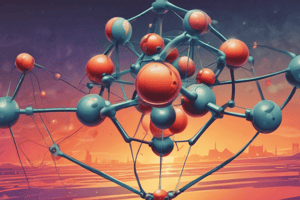Podcast
Questions and Answers
What type of bond forms when two pairs of electrons are shared between two atoms?
What type of bond forms when two pairs of electrons are shared between two atoms?
- Double bond (correct)
- Triple bond
- Single bond
- Pi bond
Which group of elements forms four single covalent bonds?
Which group of elements forms four single covalent bonds?
- Group 17
- Group 15
- Group 16
- Group 14 (correct)
What is the strength of a covalent bond dependent on?
What is the strength of a covalent bond dependent on?
- Type of orbital overlap
- Number of valence electrons
- Distance between the nuclei (bond length) (correct)
- Atomic number of the elements involved
In which type of reaction does more energy get released during product bond formation than is required to break bonds in the reactants?
In which type of reaction does more energy get released during product bond formation than is required to break bonds in the reactants?
What happens in a triple bond?
What happens in a triple bond?
Which type of orbital overlap results in the formation of a pi bond?
Which type of orbital overlap results in the formation of a pi bond?
What type of bond results from electron sharing between atoms in non-ionic compounds?
What type of bond results from electron sharing between atoms in non-ionic compounds?
Why do atoms bond together?
Why do atoms bond together?
Which type of elements primarily form covalent bonds?
Which type of elements primarily form covalent bonds?
What is the result of sharing only one pair of electrons between atoms?
What is the result of sharing only one pair of electrons between atoms?
In a Lewis structure, what does a line or dots represent?
In a Lewis structure, what does a line or dots represent?
Why do diatomic molecules like H2 and O2 exist?
Why do diatomic molecules like H2 and O2 exist?
Flashcards are hidden until you start studying
Study Notes
Halogens and Single Covalent Bonds
- Halogens (Group 17 elements) have 7 valence electrons and form single covalent bonds with non-metal atoms.
- Examples of single covalent bonds include hydrogen fluoride (HF) and chlorine (Cl2).
Group 16 and Single Bonds
- Atoms in Group 16 can share two electrons and form two covalent bonds, such as in water (H2O) with one oxygen atom bonded to two hydrogen atoms.
Group 15 and Single Bonds
- Atoms in Group 15 form three single covalent bonds, such as in ammonia (NH3).
Group 14 and Single Bonds
- Atoms of Group 14 elements form four single covalent bonds, such as in methane (CH4).
Lewis Structure of a Molecule
- A Lewis structure represents the arrangement of electrons in a molecule.
- Steps to draw a Lewis structure: write the Lewis Dot structures, erase one electron from each and draw a bond, count all lone electrons and bonds, and check for octet.
Sigma Bonds
- Single covalent bonds are also called sigma bonds.
- Sigma bonds occur when the pair of shared electrons is in an area centered between the two atoms.
Multiple Covalent Bonds
Double Bonds
- A double bond forms when two pairs of electrons are shared between two atoms.
Triple Bonds
- A triple bond forms when three pairs of electrons are shared between two atoms.
Pi Bonds
- A multiple covalent bond consists of one sigma bond and at least one pi bond.
- Pi bonds form when parallel orbitals overlap and share electrons.
The Strength of Covalent Bonds
Bond Length
- The strength of a covalent bond depends on the distance between the two nuclei (bond length).
- As bond length increases, strength decreases.
Bonds and Energy
- The amount of energy required to break a bond is called the bond dissociation energy.
- An endothermic reaction occurs when a greater amount of energy is required to break existing bonds than is released during product bond formation.
- An exothermic reaction occurs when more energy is released during product bond formation than is required to break bonds in the reactants.
Why Do Atoms Bond?
- Atoms bond to gain stability and achieve a lower energy state.
- Valence electron sharing allows atoms to acquire the stable electron configuration of noble gases.
Studying That Suits You
Use AI to generate personalized quizzes and flashcards to suit your learning preferences.




